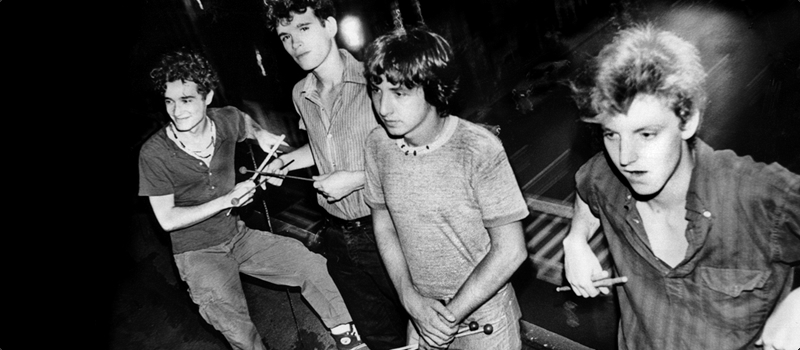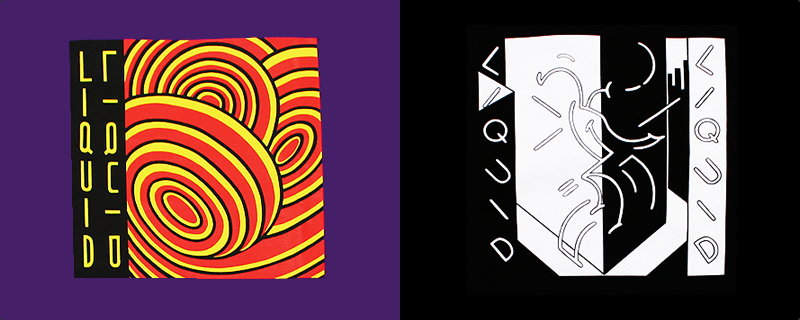Richard McGuire of Liquid Liquid
リキッド・リキッド、リチャード・マクガイアが語る
「サウンドとビジュアルの関係性」
08 5/16 UP
Interview:Paul Mittleman and Adam Weissman Translation:Shinsuke Seta


- PM :
- リキッド・リキッドとしての活動を開始する以前、あなたの興味の対象はアートにあったのですか? バンド活動を含めて何か進むべき道を決めていたのですか?
- Was art your main focus before Liquid Liquid came along? Was there ever a choice to be made? One or the other?
- RM:
- バンド活動以前はアートにのめり込んでいて、あらゆるアート誌を読みあさり、ギャラリーやミュージアムに足を運ぶ毎日でしたね。そして、そうした学生生活を送っていた頃に、ブライアン・イーノ、パティ・スミス、ディーボ、トーキングヘッズ、テレヴィジョンといった全く新しい音楽に出会ったんですよ。それらのバンドはまさに「アート・バンド」のように僕には思えたんです。だから僕がバンドを始めたのも、自然な成り行きでしたね。バンドはドラムのスコット・ハートリーと共に始めました。その頃、彼は哲学を専攻する大学生で、僕はアートを専攻しながらニューヨークのギャラリーでアルバイトをしていました。初めのうちは、バンドといっても何をどうして良いのか分からず、ただひたすらジャムセッションを行うばかりでしたね。ただ、そのようなアプローチは今思うと正解でした、僕達は他の誰とも違うサウンドをやってみたかったんです。僕達の初期のコンサートのポスターでは、オーディエンスに楽器を会場に持参するように呼びかけたりもしましたね。そのようなことを行っていたので、初期のコンサートはまるでアートパフォーマンスのようなカオスに満ちた状態になっていました。1978年には7インチ盤を作ることになったのですが、僕にとってレコードをリリースするということは、アートオブジェクトを創作するようなものでした。数種類のエディションや、量産プロダクトを手掛けるということは当時の潮流となりつつあったマスプロダクトアートそのものだったんですよ。
- Before the band I was heavily into art, reading all the art magazines, going to gallery and museum shows. While I was in school suddenly all this new music started popping up; Brain Eno, Patti Smith, Devo, Talking Heads, Television. All these bands seemed like 'art-bands'. So it just seemed logical to start a band. I started the band with Scot Hartley (drums). He was a philosophy major. I was majoring in art and working part time at a gallery in New York. At first we didn't know what we were doing, just making crazy jams. It was completely honest in it's approach, we weren't tying to sound like anyone. On the posters of our first shows we encouraged people to bring instruments. Those shows were chaotic like an art performance. We decided to make a 7" record, this was in 1978. For me it was about creating an object, like an art object. The idea of making editions, multiples, a mass produced art was a growing interest.
- PM :
- EPのアートワークに込められたコンセプトとはどのようなものだったのですか? それらのアートワークとレコードに収録された曲には直接的な関連があったのですか?
- What were the ideas behind the artwork from the EPs? Were they directly related to the songs on the records?
- RM:
- 歌そのものというより僕達が作り出すサウンドをアートワークに反映させようとしました。最初の作品である『The B+W one』のスリーブは、間違いなく当時のグラフィティ・シーンからの影響を受けていますね。グラフィティ特有のまるで外国語のような言葉や、ある種の暗号のようにも見える言葉というのは、私にとってとても新鮮でミステリアスなものだったんです。当時のグラフィティはとても活気に満ちていて、その影響を受けないことの方が不自然でしたね。グラフィティに触発された僕のアートワークは、当時のグラフィティに比べると、やや控えめな印象のものですが、躍動するタイポグラフィのアイディアなどはまさにグラフィティアートから来ているんですよ。また、アートワークに見られる抽象像は"Liquid Liquid"という単語と、いくつかの感嘆符をミックスして出来上がったものですね。『Optimo』のアートワークは赤、黒、黄色の曲線を大胆に使用したことで、やや力強い印象に仕上がっています。当時の僕達は、まるで4つの渦巻く竜巻の中心で音楽を作っているような雰囲気を持った、そんなパワフルでリズミカルな音楽を作り出していたんです。だから、『Optimo』のアートワークにはそのフィーリングを反映させなければいけないと思ったんです。実際に見てもらえば分りますが、『Optimo』のカバーにある"Liquid Liquid"のフレーズは(縦横)二方向から読むことが出来るんです。"Liquid Liquid"と読むには、カバーを動かして読まなければならないというアイディアが良くて、それでこのカバーアートを制作したんですよ。実際にカバーアートを動かすことで、闇の中に瞬くネオンサインのような、そんなリズミカルな動きが発生しますよね。そのように一見しただけではその意味が分からないタイポグラフィが好きだったんです。
- I was trying to reflect the sound we were making, not songs specifically. On the first sleeve, the B+W one, I was definitely influenced by graffiti. That was all still new and mysterious to me, these crazy words, like a foreign language or a code of some kind. It all had such life and movement to it you couldn't help being influenced by it. My response to it was more controlled and modest by comparison but the idea of type jumping off the page and dancing on a street corner really comes from graffiti. The abstract figure is literally made out of the words 'Liquid Liquid' mixed with some exclamation points. The Optimo record is more bold, with red, black and yellow swirling shapes. There were times the music we were making at that point felt like standing in the middle of four tornados all swirling around, it was so powerful rhythmically. The image had to reflect the feeling of that. The words "Liquid Liquid" can be read in two directions. I liked that you had to move it to read it. There's a rhythmic 'movement', like a blinking neon sign. I liked that the type wasn't immediately understood.


